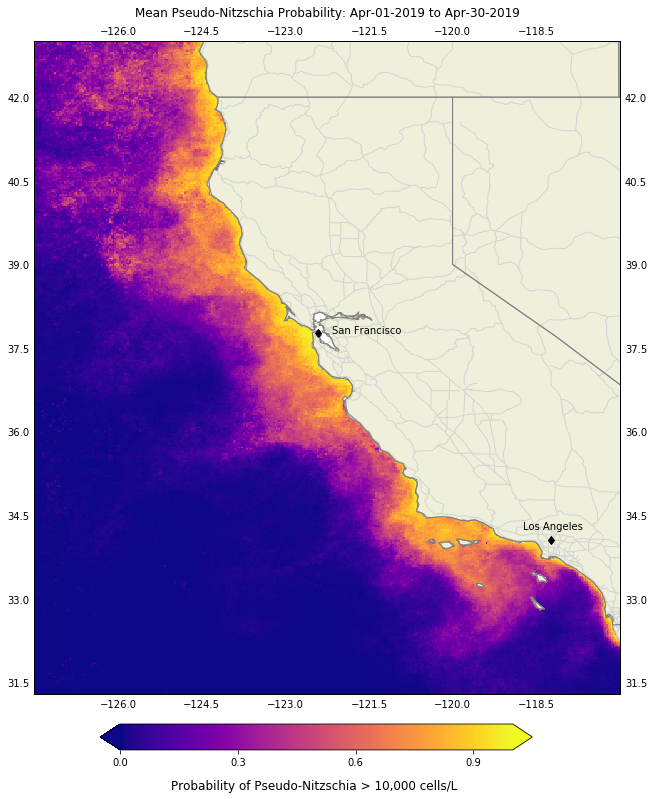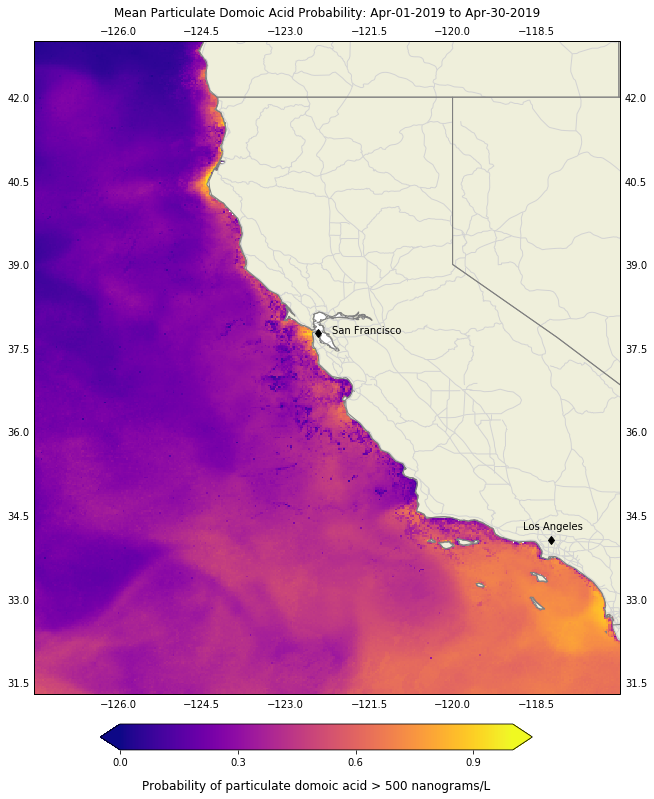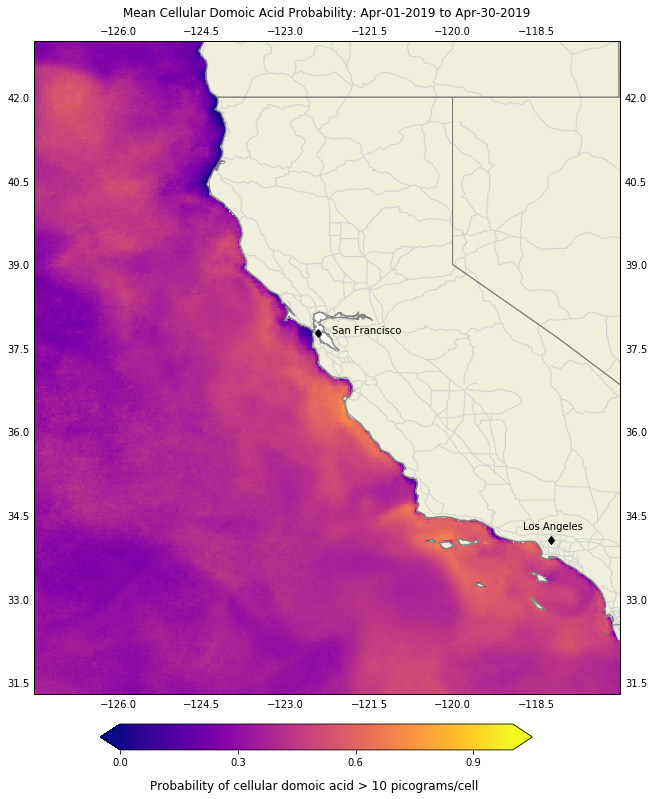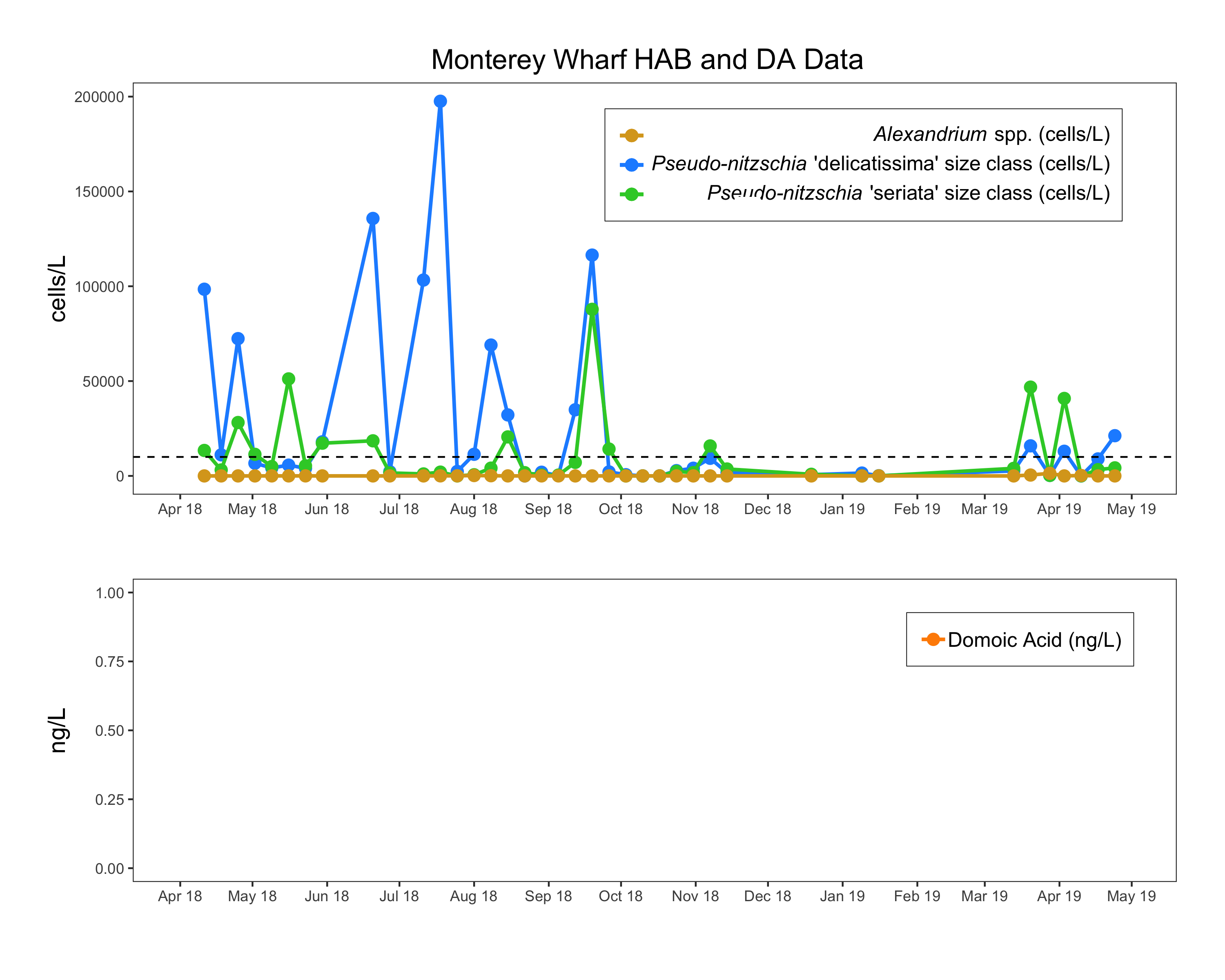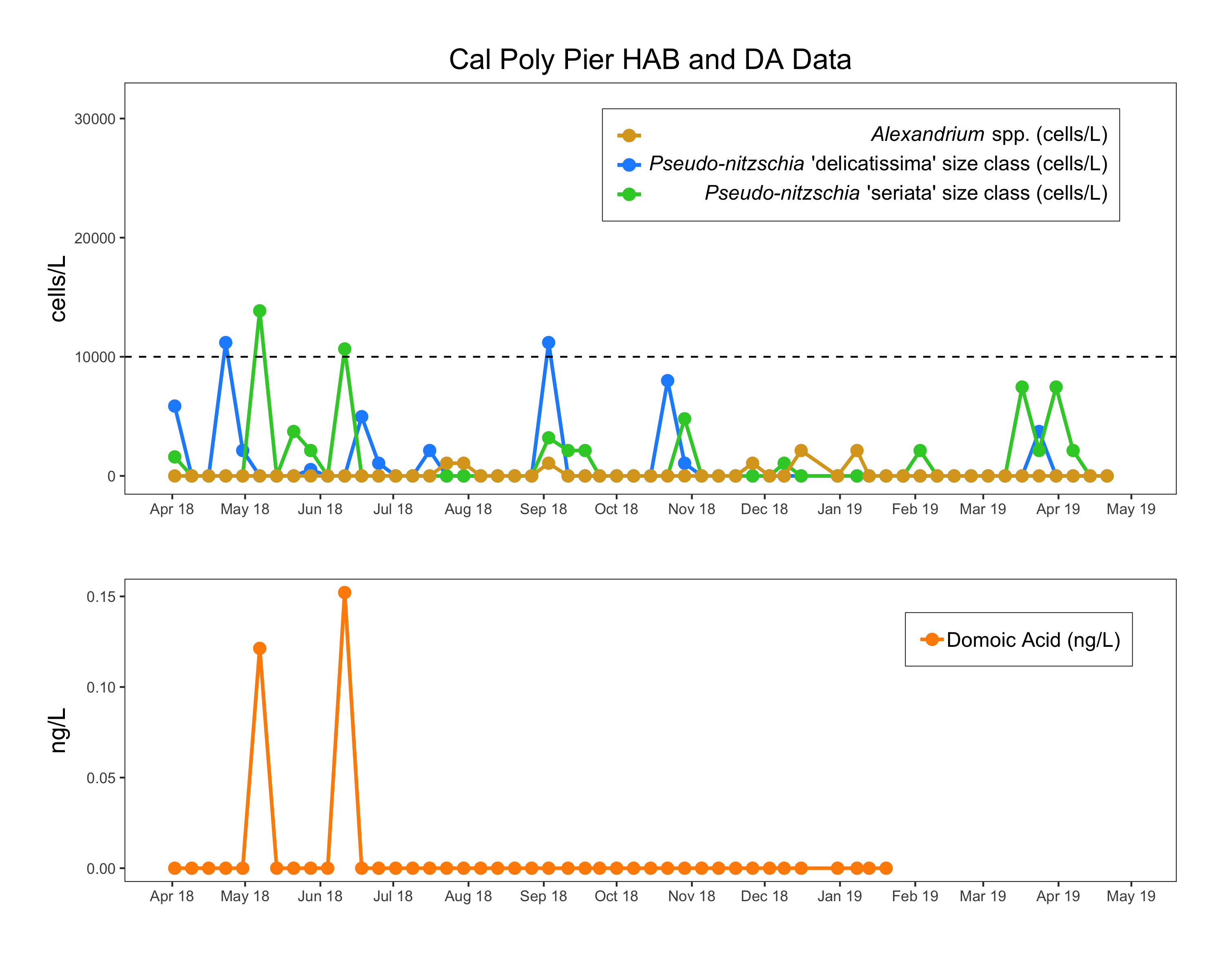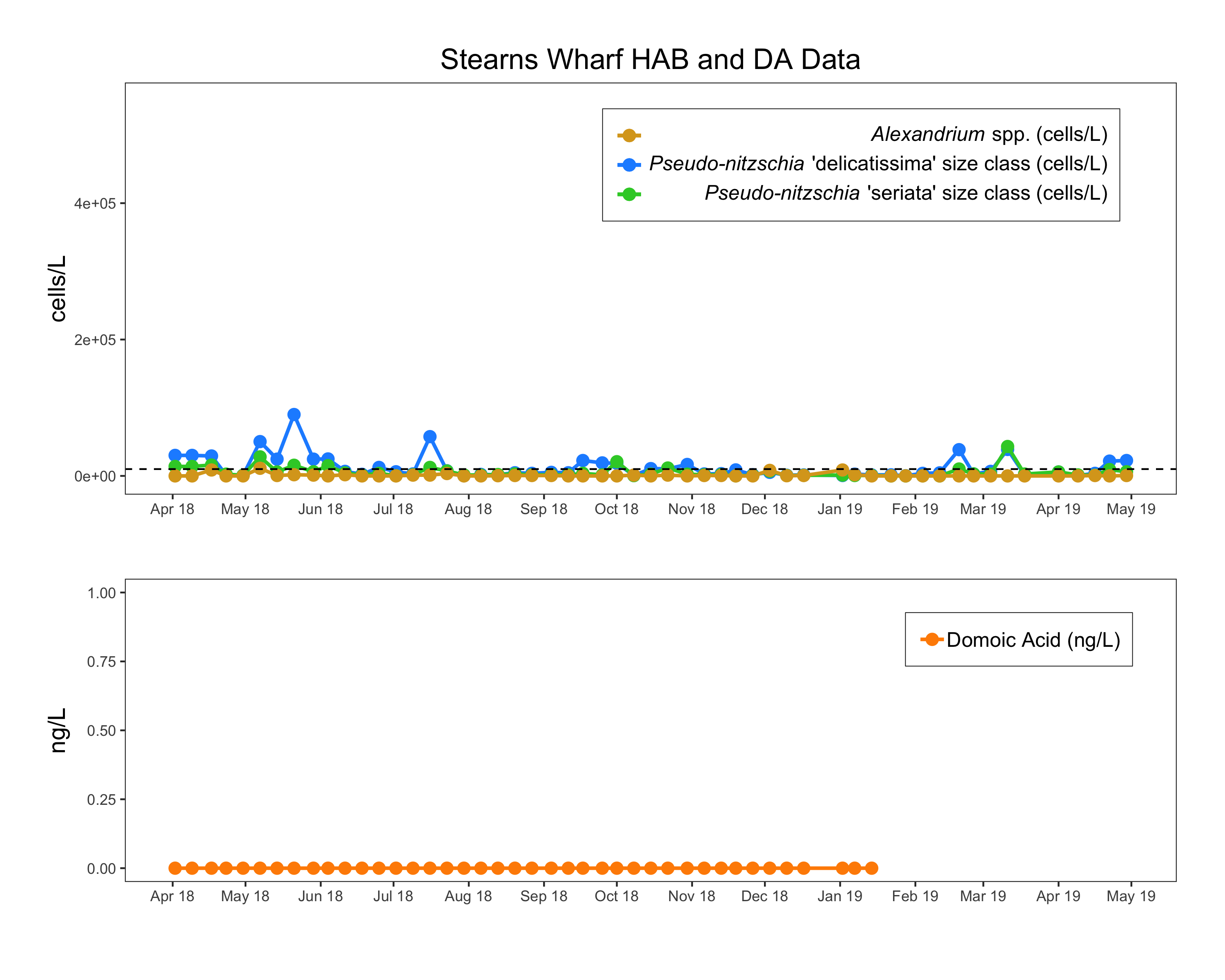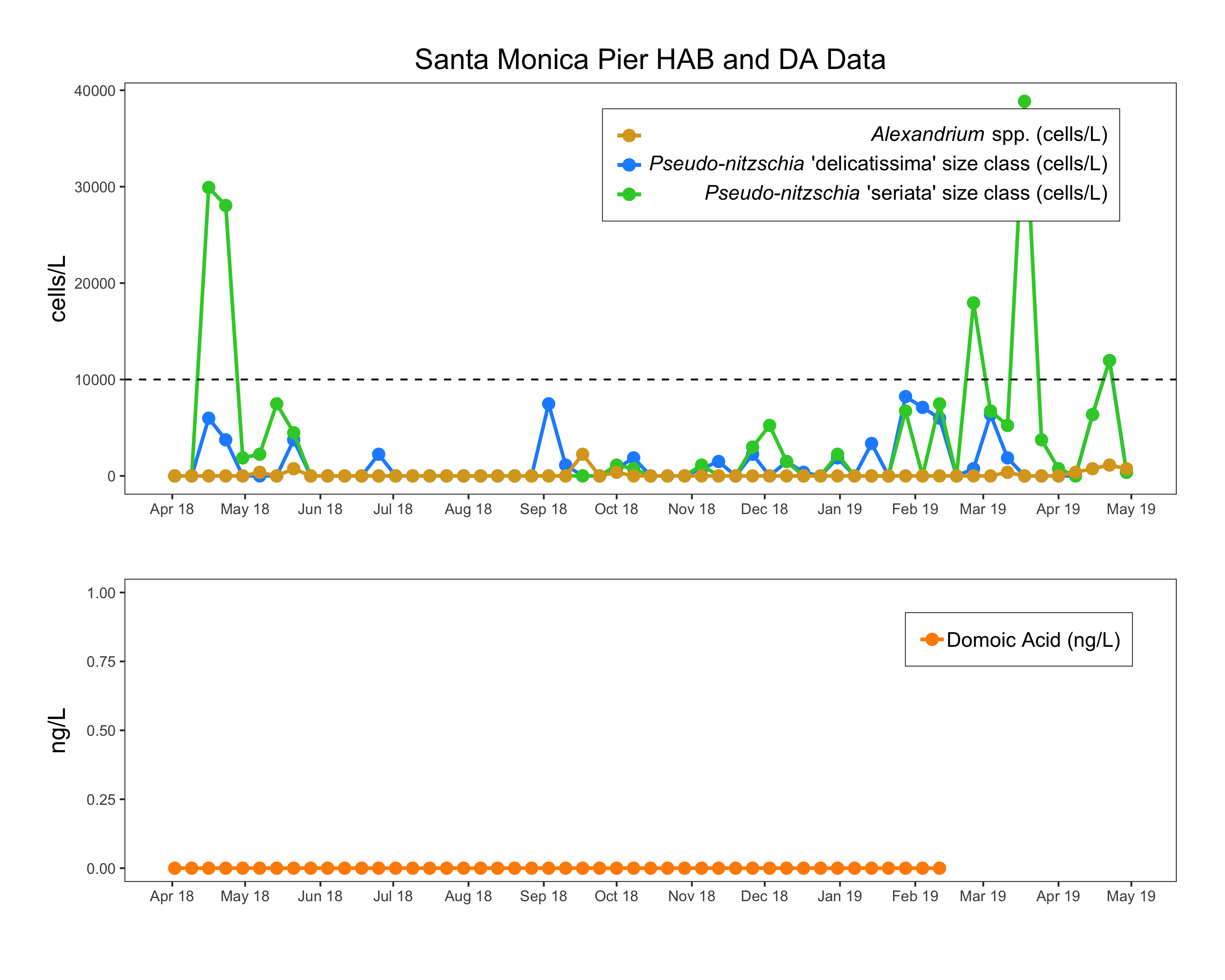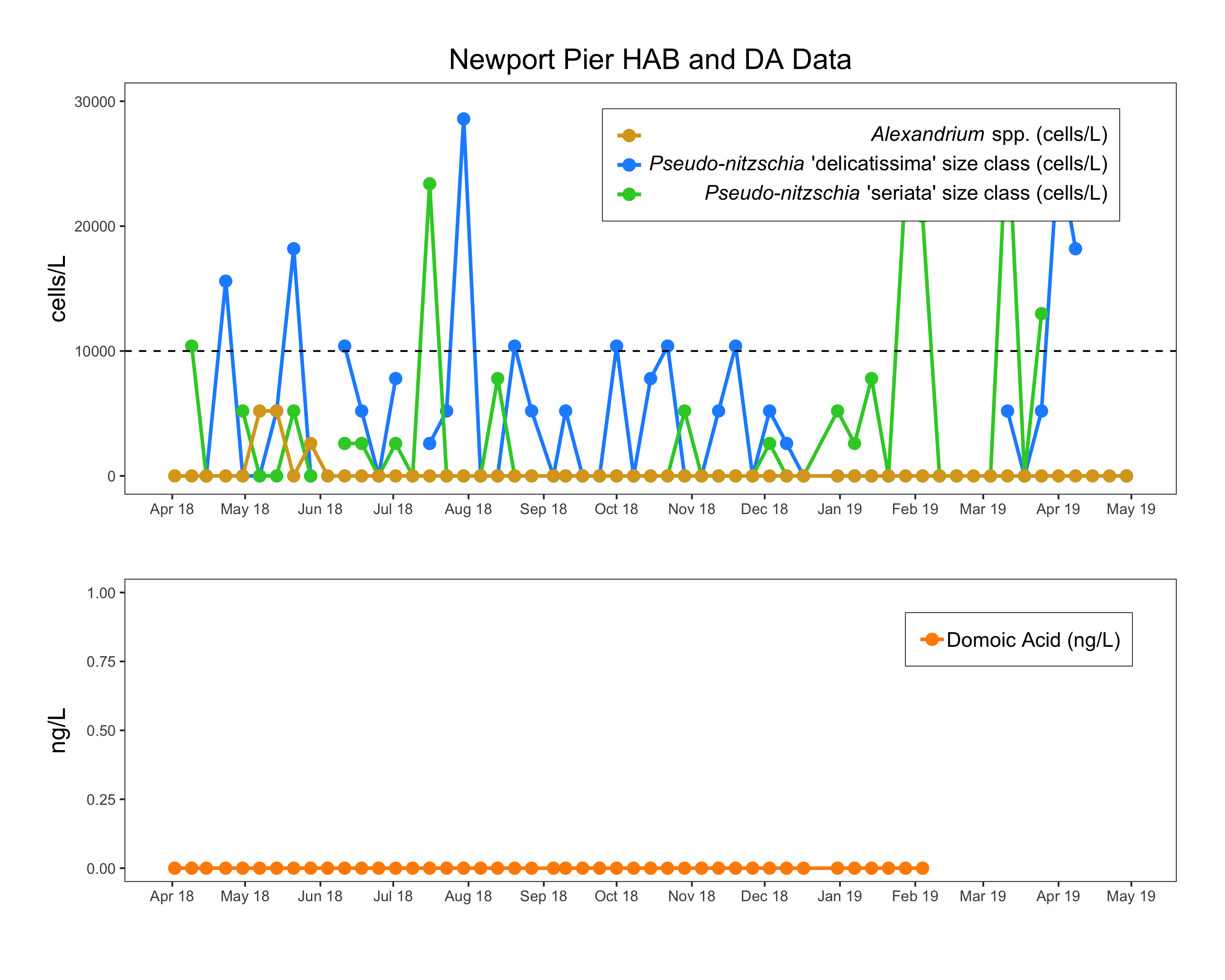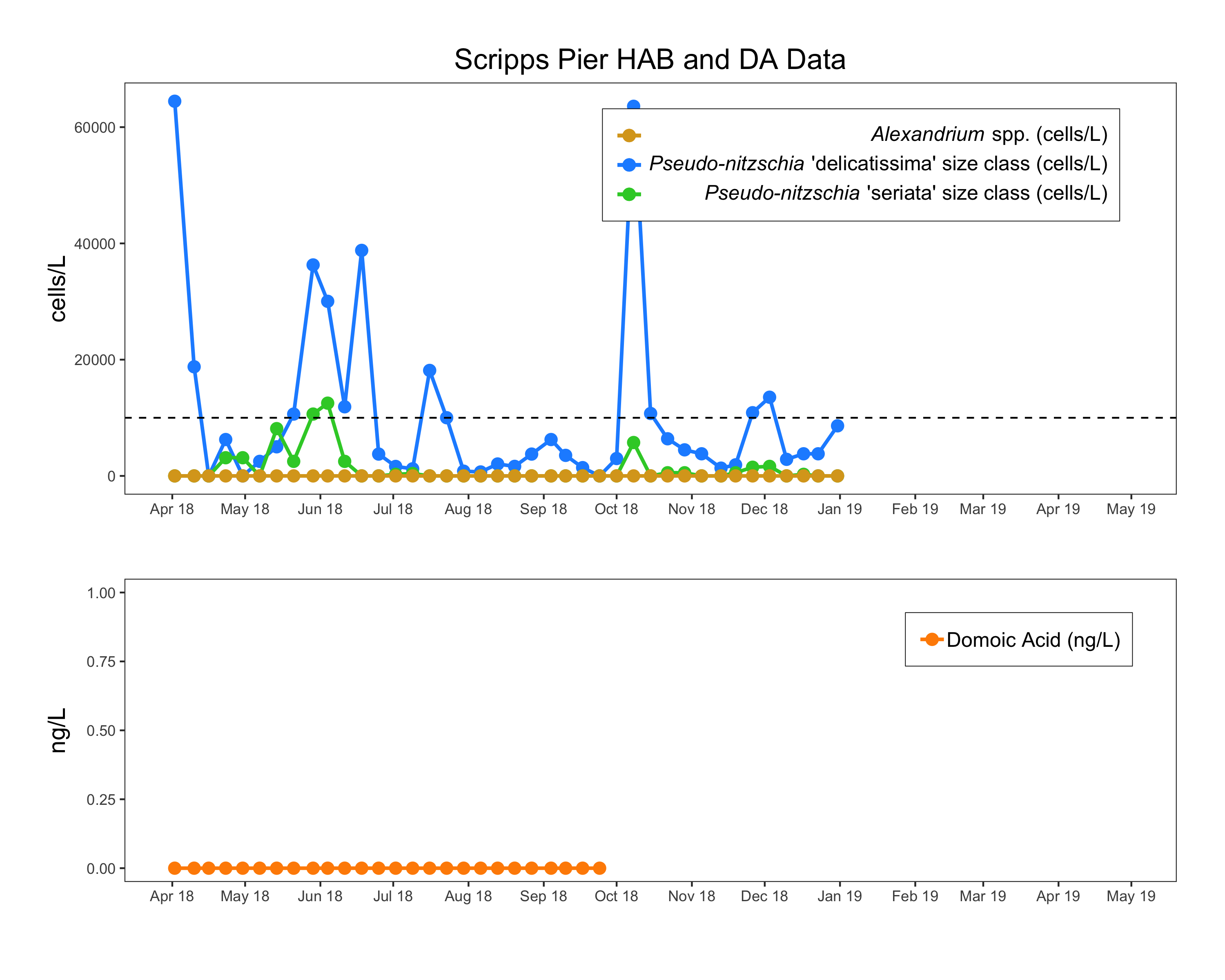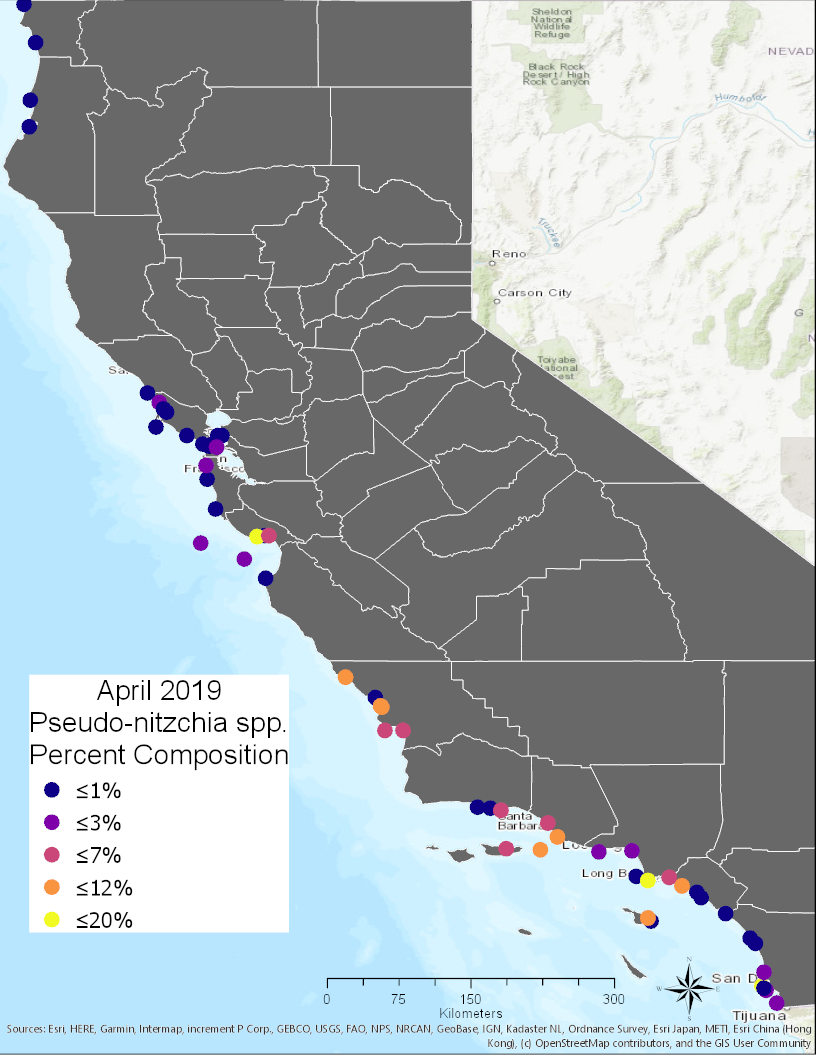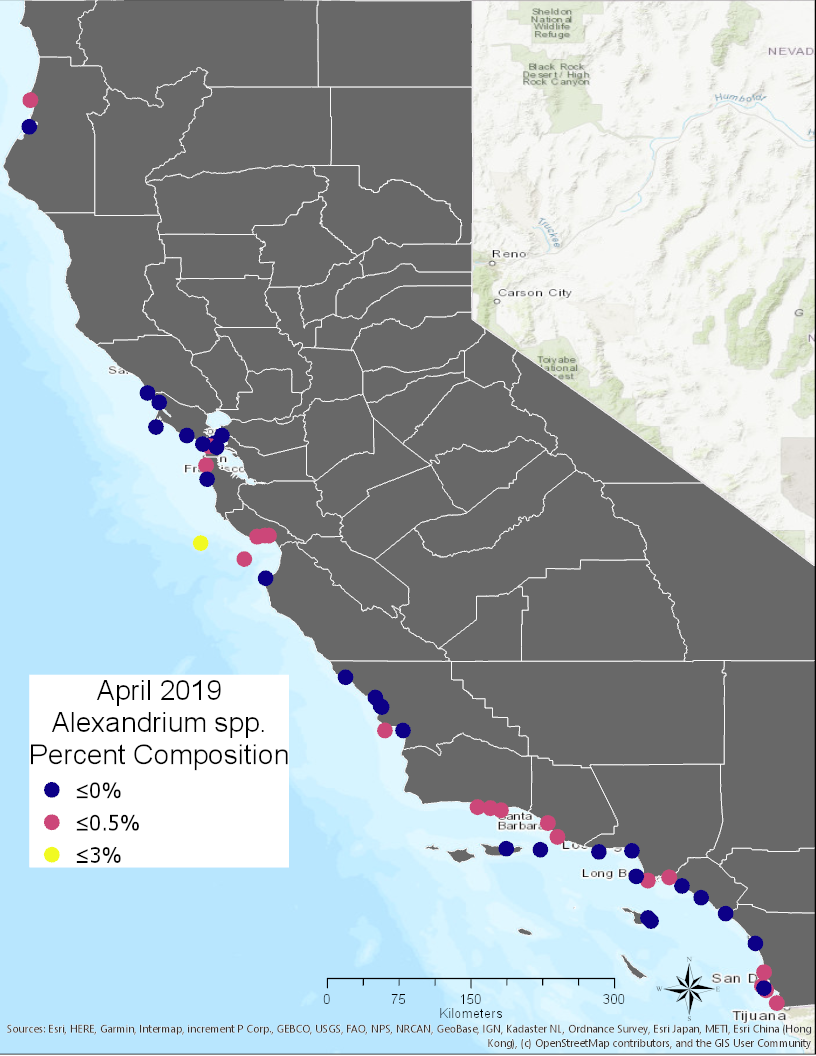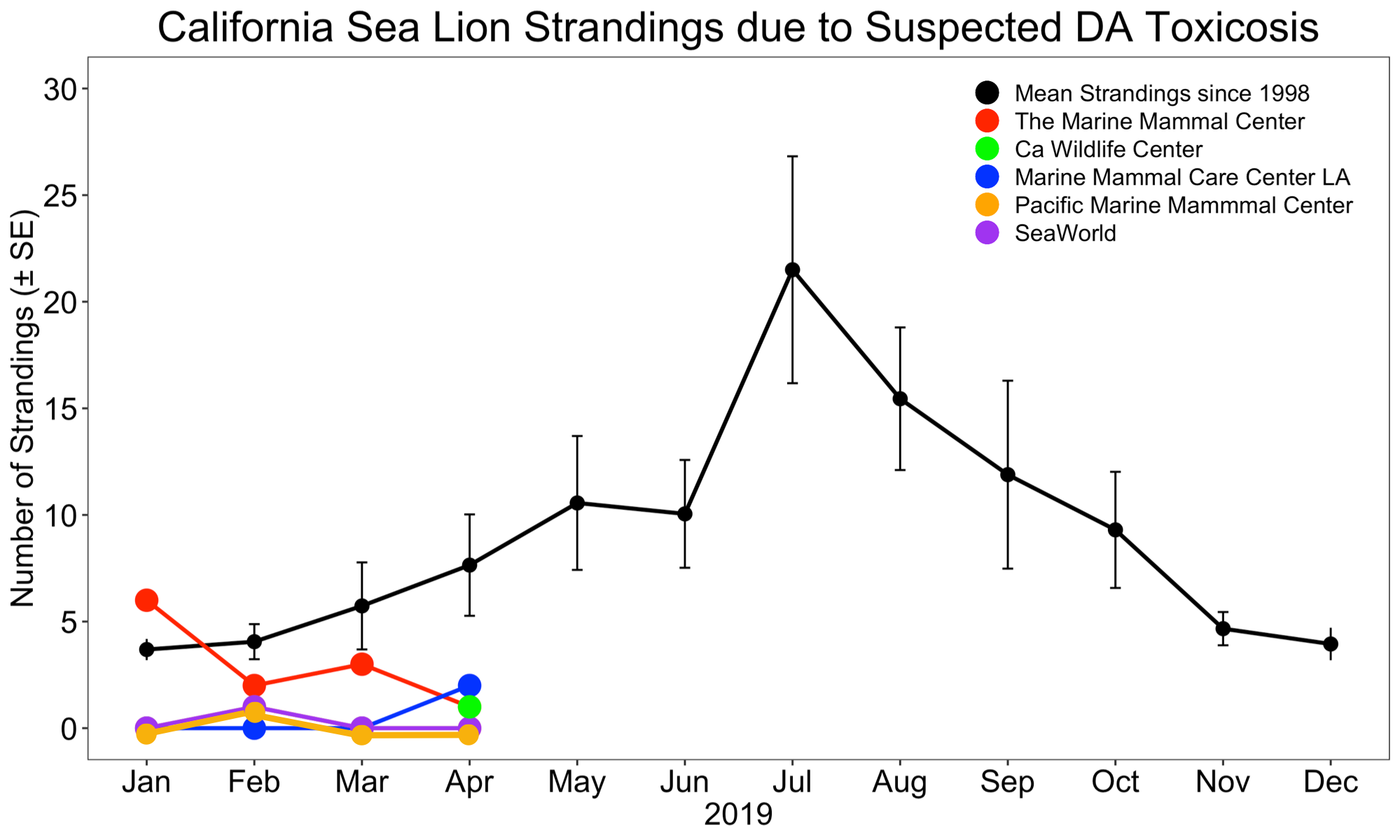Pseudo-nitzschia - C-HARM tells us where conditions are suitable for Pseudo-nitzschia spp. (all size classes) to grow well and where they might be more likely to produce domoic acid (DA). As in March, C-HARM probabilities for blooms for April are highest from the Santa Barbara Channel north, offshore to nearshore, with high nearshore probabilities in the Southern California Bight. The persistency of this pattern over the last several months suggests model re-tuning may be necessary, although observations at the piers do align with this pattern for the most part (keeping in mind we have no offshore observations with which to validate the model). HABMAP observations of Pseudo-nitzschia spp. abundance indicate bloom conditions for mostly "seriata" (toxigenic) and to some extent "delicatissima" (non-toxigenic) size-classes at all the pier stations from, intensity building as we move southward (just as was the pattern in March). P. seriata size class abundances were in the 30-40,000 cells per Liter range for Southern California sights, although no data are yet available for Scripps Pier in San Diego. CDPH sampling in April shows highest Pseudo-nitzschia percent composition in the San Pedro Basin (LA area), Santa Barbara Channel, central coast near San Luis Obispo, and northern Monterey Bay near Santa Cruz, a similar pattern to March.
Domoic Acid - C-HARM also tells us where DA might be more likely to occur at high levels. April observations of DA are not yet available for any of the HABMAP pier sampling sites. Probabilities of particulate DA (pDA) are most pronounced in the nearshore regions of the North Coast, pockets outside SF Bay and Monterey Bay, around Pt Conception where spring westerly to northwesterly winds are likely producing high wind stress curl and upwelling nutrient-rich waters that fuel blooms, and throughout the nearshore and offshore waters of the Southern California Bight. High cellular DA (cDA) probabilities in the Bight and along the central coast are consistent with the predicted Pseudo-nitzschia growth in that area, where cDA production might also be peaking. The three of the four sea lion strandings from DA toxicosis in the month of April were recorded in the LA and Long Beach area, consistent with high probabilities of pDA (and cDA) in those zones and with high observed abundance of the P. seriata size class (more toxigenic group of Pseudo-nitzschia) at Newport Beach Pier and Santa Monica Pier. The sea lion stranding on the central coast is consistent with high probabilities of pDA (and cDA) and elevated measures of P. seriata size class at Stearns Wharf and Cal Poly Pier.
Alexandrium - HABMAP records for Alexandrium at pier sites show little activity from January to April 2019, which is consistent with little or no increases in the relative abundance of this dinoflagellate as measured by the CDPH volunteer phytoplankton monitoring network. However, as we moved into May, things got interesting as evidenced by the high % composition of Alexandrium from CDPH in offshore Monterey Bay waters.... stay tuned.
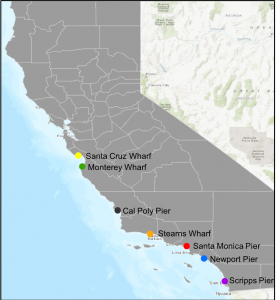
HABMAP Monitoring Sites
Note that data for some stations are not shown because they are not yet recorded in the public HABMAP archive.
Differentiating Pseudo-nitzschia species by light microscopy is difficult. For this reason, Pseudo-nitzschia "seriata" does not refer to an actual species but rather the larger size class of Pseudo-nitzschia, which is generally a more toxigenic group of species. Alternatively, Pseudo-nitzschia "delicatissima" refers to the smaller size class that is generally non-toxigenic. The dashed line on the plots demarcates the 10,000 cells/L "bloom" threshold designated here for Pseudo-nitzschia populations only.
Santa Cruz Wharf
Water samples were collected four times at Santa Cruz Municipal Wharf in the month of April. Pseudo-nitzschia seriata group was detected below bloom levels and Alexandrium spp. were detected above bloom levels on April 24th. Domoic Acid results are not yet available for the month of April.
Santa Cruz Municipal Wharf does not measure for Pseudo-nitzschia delicatissima group.
Monterey Wharf
Water samples were collected at Monterey Wharf four times in the month of April. Pseudo-nitzschia seriata group and Pseudo-nitzschia delicatissima group were detected above bloom levels on April 3rd, 17th, and 24th. Alexandrium spp were not detected in any of the April samples. Domoic Acid results are not yet available for the month of April.
Cal Poly Pier
Water samples were collected at Cal Poly Pier three times in the month of April. Pseudo-nitzschia seriata group was detected above bloom levels on April 7th. Pseudo-nitzschia delicatissima group and Alexandrium spp. were not detected in any of the samples. Domoic Acid results are not yet available for the month of April.
Stearns Wharf
Water samples were collected at Stearns Wharf five times in the month of April. Pseudo-nitzschia delicatissima group and Pseudo-nitzschia seriata group were detected above bloom levels on April 16th, 22nd, and 29th. Alexandrium spp. were detected below bloom levels on April 16th and 29th. Domoic Acid results are not yet available for the month of April.
Santa Monica Pier
Water samples were collected at Santa Monica Pier five times in the month of April. Pseudo-nitzschia delicatissima group and Pseudo-nitzschia seriata group were detected above bloom levels on April 15th and 22nd. Domoic Acid results are not yet available for the month of April.
Newport Beach Pier
Water samples were collected at Newport Beach Pier five times in the month of April. Pseudo-nitzschia delicatissima group and Pseudo-nitzschia seriata group were detected above bloom levels and Alexandrium spp. were not detected in any of the samples. Domoic Acid results are not yet available for the month of April.
Scripps Pier
Scripps Pier Pseudo-nitzschia spp., Alexandrium spp., and domoic acid results are not yet available at this time.
CDPH observations for Pseudo-nitzschia spp. and Alexandrium spp.
From 1-30 April 2019, water samples were collected by volunteers and sent to the California Department of Public Health (CDPH) for analysis. Pseudo-nitzschia spp. were detected in 48 of the 57 samples. Pseudo-nitzschia spp. was recorded at Common density levels in six of the samples including on April 13th at Palos Verdes (20% composition), April 5th at CDFG Trawl Block (15%) and on April 24th at Santa Cruz Pier (15% composition). Alexandrium spp. were detected in low levels in all 20 of 49 samples in the month of April. You can also view CDPH weekly map layers of Pseudo-nitzschia and Alexandrium here.
Data are provided by the California Department of Public Health, Environmental Management Branch.
CDFW Health Advisories
The California Department of Fish and Wildlife (CDFW) issued a health advisory on May 10th to not eat sport-harvested mussels, clams or scallops in Santa Cruz County due to PSP toxins. The safety notification is in addition to the annual mussel quarantine starting May 1st.
For the latest closures and updates, please visit the CDFW Health Advisories page.
Domoic acid (DA) is a potent neurotoxin produced by some diatom species of the genus Pseudo-nitzschia. Species exposed to DA can result in seizures, epilepsy, cardiomyopathy, and death depending upon the ingested dose. DA toxicosis commonly occurs in California Sea Lions (Zalophus Californianus), presumably due to a combination of foraging behavior and seasonal movements. The Marine Mammal Center (TMMC), the California Wildlife Center, the Marine Mammal Care Center Los Angeles (MMCC-LA), the Pacific Marine Mammal Center (PMMC), and SeaWorld act like an emergency room by working to rescue and rehabilitate sick and injured marine mammals, seabirds, and sea turtles.
TMMC, Ca Wildlife Center, MMCC-LA, and SeaWorld recorded a total of four sea lion strandings and one seabird stranding presented with symptoms of domoic acid toxicosis in the month of April.
No DA toxicosis cases have been reported by the Pacific Marine Mammal Center in April 2019.
April marine mammal and seabird strandings suspected due to DA toxicosis occurred at the following locations:
- April 8th, 2019 - California Sea Lion stranded at Long Beach, Los Angeles County - MMCC-LA
- April 9th, 2019 - California Sea Lion stranded in Los Angeles County - MMCC-LA
- April 17th, 2019 - California Sea Lion, Dog Beach, Avila Beach, San Luis Obispo County - TMMC
- April 19th, 2019 - California Sea Lion stranded at Zuma Beach, Malibu, Los Angeles County - CA Wildlife Center
- April 19th, 2019 - Brandt’s Cormorant, Ocean Beach, San Diego County - SeaWorld
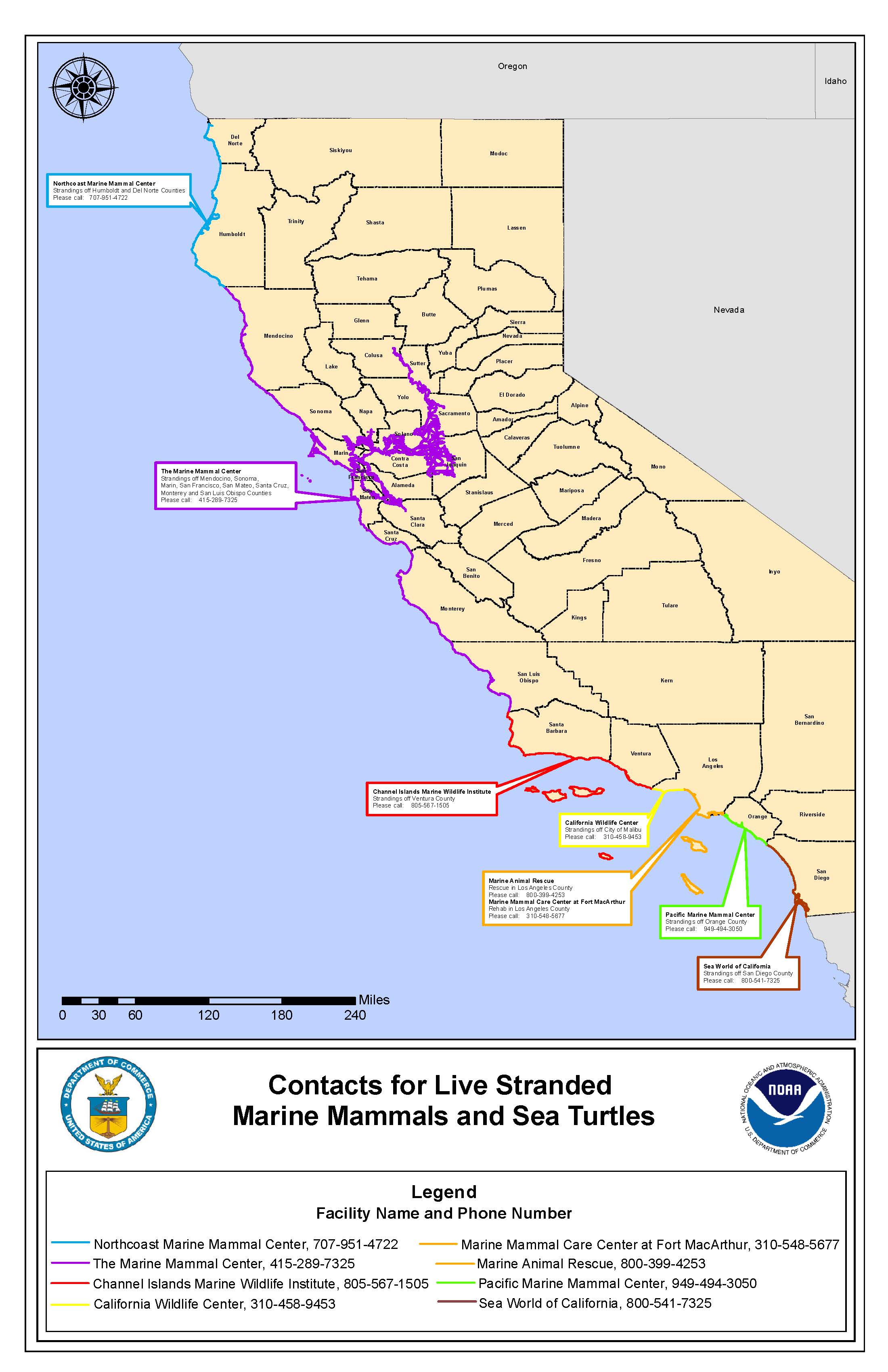
Who to call if you find a LIVE stranded marine mammal or sea turtle
Sea World of California (800) 541-7325
- San Diego County
Pacific Marine Mammal Center (949) 494-3050
- Orange County
Marine Animal Rescue (800) 399-4253 and California Wildlife Center (310) 458-9453
- Los Angeles County
Channel Islands Marine Wildlife Institute (805) 567-1505
- Santa Barbara County
- Ventura County
The Marine Mammal Center (415) 289-7325
- Alameda County
- Contra Costa County
- Marin County
- Mendocino County
- Monterey County
- Napa County
- Sacramento County
- San Francisco County
- San Luis Obispo
- San Mateo County
- Santa Cruz County
- Sonoma County
Northcoast Marine Mammal Center (707) 951-4722
- Del Norte County
- Humboldt County

